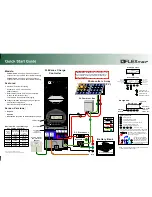DR
AFT
DR
AFT
DRAFT
DR
D
RAFT
DRAFT
DRA
FT DRAF
D
RAFT DRAFT DRAFT DRAFT DRAFT D
DRAFT
D
RAFT DRA
FT DRAFT DRAFT DRAFT DRA
UM10316_0
© NXP B.V. 2008. All rights reserved.
User manual
Rev. 00.06 — 17 December 2008
84 of 571
NXP Semiconductors
UM10316
Chapter 8: LPC29xx event router
Input events are processed in event slices; one for each event signal. Each of these slices
generates one event signal and is visible in the RSR (Raw Status Register). These events
are then AND-ed with enables from the MASK register to give PEND (PENDing register)
event status. If one or more events are pending the output signals are active.
An event input slice is controlled through bits in the APR (Activation Polarity Register), the
ATR (Activation Type Register), INT_SET (INTerrupt SET) and INT_CLR (INTerrupt
CLeaR).
•
The polarity setting (APR) conditionally inverts the interrupt input event.
•
The activation type setting (ATR) selects between latched/edge or direct/level event.
•
The resulting interrupt event is visible through a read-action in the RSR.
•
The RSR is AND-ed with the MASK register and the result is visible in the PEND
register.
•
The wake-up (CGU) and interrupt (VIC) outputs are active if one of the events is
pending.
2.1 Event router pin connections
The event router module in the LPC29xx is connected to the pins listed below. The pins
are combined with other functions on the port pins of the LPC29xx.
shows the
pins connected to the event router, and also the corresponding bit position in the
event-router registers and the default polarity.
Table 72.
Event-router pin connections
Symbol
Direction
Bit position
Description
Default
polarity
EXTINT0
IN
0
external interrupt input 0
1
EXTINT1
IN
1
external interrupt input 1
1
EXTINT2
IN
2
external interrupt input 2
1
EXTINT3
IN
3
external interrupt input 3
1
EXTINT4
IN
4
external interrupt input 4
1
EXTINT5
IN
5
external interrupt input 5
1
EXTINT6
IN
6
external interrupt input 6
1
EXTINT7
IN
7
external interrupt input 7
1
CAN0 RXDC
IN
8
CAN0 receive data input wake-up
0
CAN1 RXDC
IN
9
CAN1 receive data input wake-up
0
I2C0_SCL
IN
10
I2C0 SCL clock input
<tbd>
I2C1_SCL
IN
11
I2C1 SCL clock input
<tbd>
USB_D+1
IN
12
<tbd>
<tbd>
USB_D+2
IN
13
<tbd>
<tbd>
LIN0 RXDL
IN
14
LIN0 receive data input wake-up
0
LIN1 RXDL
IN
15
LIN1 receive data input wake-up
0
SPI0 SDI
IN
16
SPI0 data in
<tbd>
SPI1 SDI
IN
17
SPI1 data in
<tbd>
SPI2 SDI
IN
18
SPI2 data in
<tbd>
UART0 RXD
IN
19
UART0 receive data input
<tbd>


















